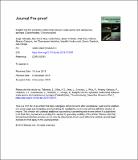Por favor, use este identificador para citar o enlazar a este item:
http://hdl.handle.net/10261/319698COMPARTIR / EXPORTAR:
 SHARE SHARE
 CORE
BASE CORE
BASE
|
|
| Visualizar otros formatos: MARC | Dublin Core | RDF | ORE | MODS | METS | DIDL | DATACITE | |

| Título: | Insights into the symbiotic relationship between scale worms and carnivorous sponges (Cladorhizidae, Chondrocladia) |
Autor: | Taboada, Sergi; Serra-Silva, Ana; Neal, Lenka; Cristobo, Javier; Ríos, Pilar; Alvarez-Campos, Patricia; Hestetun, Jon H.; Koutsouveli, Vasiliki; Sherlock, Emma; Riesgo, Ana | Palabras clave: | Medio Marino Mutualism Centro Oceanográfico de Gijón Polynoidae Neopolynoe Adaptation Phylogeny Reproduction |
Fecha de publicación: | 2020 | Citación: | Deep Sea Research - Part I - Oceanographic Research Papers 156 : 103191 (2020) | Resumen: | Symbiotic associations between polynoid scale worms and other marine invertebrates are common, but sometimes poorly understood. Compounding this problem is the fact that polynoid systematics is largely unresolved. Here, we transfer the species originally described as Nemidia antillicola chondrocladiae Fauvel (1943), and currently synonymized with Neopolynoe acanellae (Verrill, 1881), to the species Neopolynoe chondrocladiae n. comb. This species is characterized by living in association with the carnivorous sponges Chondrocladia robertballardi Cristobo, Ríos, Pomponi & Xavier, 2015 and Chondrocladia virgata Thompson, 1873. The existence of specialized chaetae in N. chondrocladiae n. comb. and the occurrence of open galleries in the sponge, derived from a gradual overgrowth of the sponge to accommodate the worm, suggest an obligate symbiotic relationship between worm and sponge. The presence of a gravid female with relatively small oocytes (maximum diameter 56.94 � 14.89 μm) suggests that N. chondrocladiae n. comb. is a gonochoristic broadcaster with a planktotrophic larva, a means of reproduction that would maximize the chances of this species finding new suitable hosts to colonize. We also provide a phylogenetic placement, using four genetic markers (18S, 28S, 16S and COI), for N. chondrocladiae n. comb. and N. acanellae, which confirms they are two different species. In addition, we also report here the occurrence of another deep-water polynoid species in association with the carnivorous sponge Chondrocladia verticillata Topsent, 1920, from the Gulf of Mexico, and place it in a phylogeny. | Versión del editor: | https://doi.org/10.1016/j.dsr.2019.103191 | URI: | http://hdl.handle.net/10261/319698 | DOI: | 10.1016/j.dsr.2019.103191 | ISSN: | 0967-0637 1879-0119 |
| Aparece en las colecciones: | (IEO) Artículos |
Ficheros en este ítem:
| Fichero | Descripción | Tamaño | Formato | |
|---|---|---|---|---|
| 28_2019_Taboada_etal_Neopolynoe systematics.pdf | 24,57 MB | Adobe PDF |  Visualizar/Abrir |
CORE Recommender
SCOPUSTM
Citations
8
checked on 30-abr-2024
WEB OF SCIENCETM
Citations
7
checked on 24-feb-2024
Page view(s)
30
checked on 03-may-2024
Download(s)
13
checked on 03-may-2024
Google ScholarTM
Check
Altmetric
Altmetric
NOTA: Los ítems de Digital.CSIC están protegidos por copyright, con todos los derechos reservados, a menos que se indique lo contrario.
